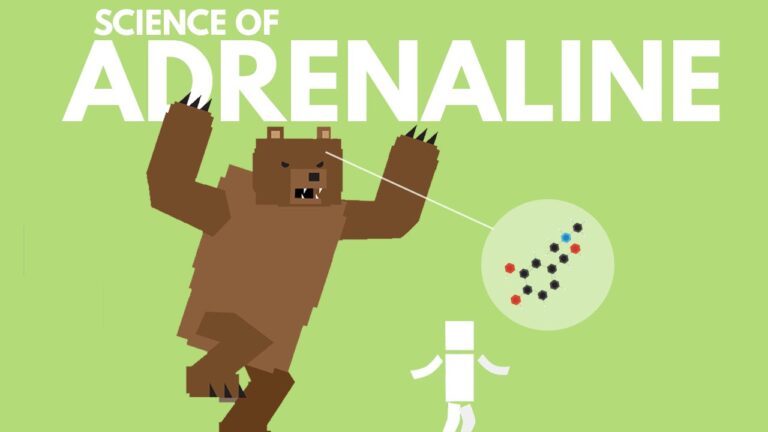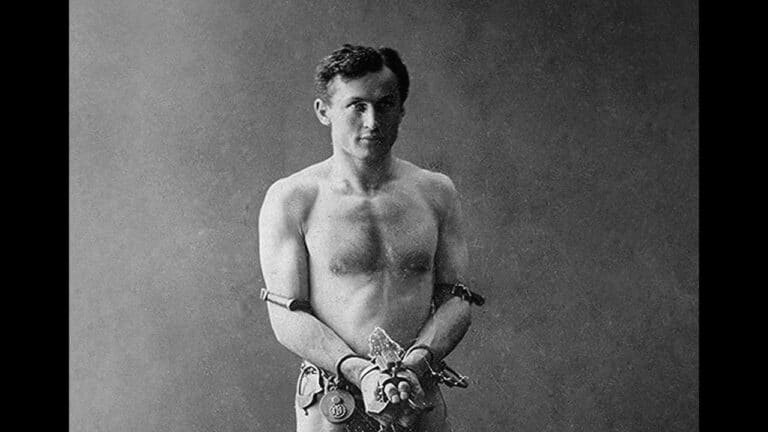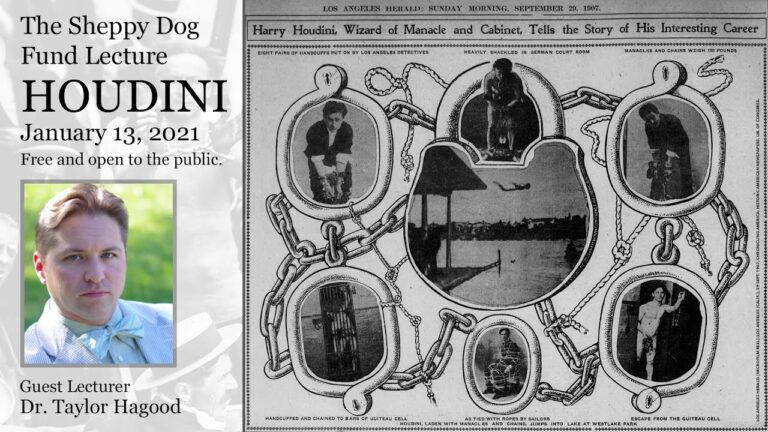The Impact of Vaudeville on Houdini’s Career: A Historical Perspective
Harry Houdini’s rise to fame began in the vibrant world of vaudeville theaters. In the late 1800s, he struggled to make ends meet as a magician until he found his place on the vaudeville stage. Vaudeville transformed Houdini from a struggling performer into America’s highest-paid vaudeville act, giving him the perfect platform to showcase his daring escapes.
You might wonder what made vaudeville so special for Houdini’s career. The answer lies in its unique format and widespread popularity. These shows attracted upscale audiences in lavish theaters, allowing Houdini to command higher fees while performing fewer shows.
The vaudeville circuit exposed him to millions of Americans and helped build his reputation as the world’s greatest escape artist.
In 1900, Houdini’s vaudeville success in America opened doors for him internationally. His European tour launched him into global stardom, and by 1904, he had become a worldwide sensation. The skills he developed on the vaudeville stage shaped his entire career and public persona.
The Early Struggles: Houdini’s Beginnings in Dime Museums

The early days of Harry Houdini’s career took shape in the gritty world of dime museums, where aspiring performers faced tough crowds and harsh conditions for minimal pay. These humble beginnings shaped his future success through hard-learned lessons and relentless determination.
The Role of Dime Museums in Early American Entertainment
Dime museums served as the training grounds for many performers in late 19th century America. These establishments offered cheap entertainment to working-class audiences for just ten cents.
The venues combined curiosities, wax figures, and live performances in cramped, often poorly ventilated spaces. Early vaudeville theaters later improved conditions with better lighting and ventilation systems.
You would find an eclectic mix of acts competing for attention – from magic shows to musical performances and oddity exhibitions.
Houdini’s Initial Performances and Challenges
Houdini performed in circuses and dime museums alongside his wife Bess during the lowest points of show business. These venues represented the bottom rung of entertainment.
The young magician often gave up to 20 shows daily for meager pay. Each performance lasted roughly 12 minutes.
His acts needed to catch and hold attention amid the noise and distractions of other simultaneous performances.
Key Lessons Learned from Dime Museum Audiences
Working-class audiences taught Houdini the value of direct, dramatic entertainment. Their reactions helped him refine his escape acts and showmanship.
These early experiences pushed him to innovate constantly. The demanding schedule built his legendary stamina and work ethic.
The tough crowds forced him to develop his signature style – bold claims backed by spectacular deliveries. This formula would later make him the highest-paid performer in American vaudeville.
Vaudeville’s Unique Entertainment Ecosystem

Vaudeville was the heart of American show business, creating a vibrant ecosystem where performers could develop their craft and build audiences. This entertainment format shaped the careers of countless artists through its structured circuits and demanding standards.
The Structure and Variety of Vaudeville Shows
Each vaudeville show featured 8-12 diverse acts performing in a strict running order. The best spots were second-to-last and third-to-last in the lineup.
Acts ranged from singers and dancers to magicians and contortionists. You would see comedy sketches followed by acrobats, then perhaps a dramatic monologue.
Theater managers carefully balanced their bills to maintain audience interest. They mixed high-brow cultural acts like opera singers with crowd-pleasing novelties like trained animals.
The Competitive Nature of Vaudeville
You had to prove yourself constantly to succeed in vaudeville. Acts competed for better time slots and higher billing on theater marquees.
Performers refined their acts through repeated performances, sometimes doing 3-4 shows daily. If you didn’t get laughs or applause, theater managers would cut your act immediately.
Even established stars like Houdini had to innovate constantly to stay relevant. The intense competition drove performers to create unique signature acts.
Audience Demographics and Expectations
Vaudeville audiences came from all social classes. Theater owners worked hard to maintain “refined” atmospheres that would attract middle-class patrons.
You could attend a show for 25 cents to a dollar, making it accessible to working families. Matinees drew women and children, while evening shows attracted more adult crowds.
Audiences expected clean entertainment without crude humor or suggestive content. Theater managers enforced strict rules about appropriate material.
Houdini’s Breakthrough on the Keith-Orpheum Circuit

In 1899, a pivotal meeting with vaudeville tycoon Martin Beck transformed Harry Houdini from a struggling performer into one of America’s highest-paid entertainers.
The Significance of the Keith-Orpheum Circuit in Vaudeville
The Keith-Orpheum Circuit represented the pinnacle of American theater entertainment in the late 1800s. Top performers earned substantial fees while gaining exposure to sophisticated audiences across major U.S. cities.
Prestigious theaters with lavish appointments defined the Circuit’s venues. This marked a dramatic upgrade from the dime museums and beer halls where Houdini previously performed.
The Circuit’s strict performance standards and professional management helped legitimize vaudeville as mainstream entertainment. For ambitious performers like Houdini, securing a spot meant both artistic validation and financial security.
Houdini’s Strategies for Securing a Spot on the Circuit
Houdini carefully crafted his act to appeal to Circuit audiences. He replaced crude escape tricks with more theatrical presentations that highlighted his showmanship.
He built relationships with influential theater managers and worked closely with Martin Beck to refine his performances.
His marketing genius showed in his bold promotional tactics. He challenged local police to restrain him and generated press coverage through public escapes.
Notable Performances and Milestones
In 1900, Houdini commanded top billing as “the genius of escape” on the Orpheum Circuit. His handcuff act became the most talked-about performance in vaudeville.
Your understanding of his success must include his legendary challenges to police departments. In each city, he invited officers to bring their strongest restraints, turning simple escapes into headline-making events.
His appearances drew record crowds. Theater managers extended his bookings from standard one-week runs to multi-week engagements, a rare honor in vaudeville.
The Influence of Vaudeville’s Competitive Atmosphere
The fierce competition on vaudeville stages pushed performers to develop unique acts that would captivate audiences and secure coveted spots in theater lineups. Vaudeville’s intense competitive environment shaped how acts evolved and adapted to survive.
Development of Houdini’s Signature Escape Acts
Your exposure to vaudeville’s demanding environment will help you understand how Houdini crafted his famous escapes. He started with simple handcuff tricks but quickly realized that basic magic wouldn’t be enough to stand out.
The competitive pressure forced him to create increasingly dangerous and complex escapes. His strait jacket escape, performed while hanging upside down from buildings, emerged from this need to offer something spectacular.
Each new act had to be more impressive than the last. You can see how this pushed him to develop the Chinese Water Torture Cell and the Buried Alive stunt – acts that no other performer dared to attempt.
Adaptation to Diverse Audience Preferences
In vaudeville’s complex social landscape, you had to appeal to different classes and backgrounds. Houdini mastered this by combining physical feats with theatrical storytelling.
He adapted his performance style for:
- High-class theaters: Emphasizing mystery and sophistication
- Working-class venues: Focusing on raw strength and courage
- Family shows: Including comedy and audience participation
His marketing changed too. You might notice how he used different promotional angles depending on the venue and audience.
The Impact of Peer Performers and Rivals
When you examine Houdini’s career, you’ll see how other performers shaped his act. He faced constant challenges from imitators and rivals trying to replicate or expose his methods.
This competition drove him to patent his tricks and create new ones that others couldn’t copy. His famous Milk Can escape came directly from trying to outdo rival escape artists.
Your understanding of his success must include his aggressive approach to competition. He would attend rivals’ shows and expose their methods, establishing himself as the only authentic escape artist in vaudeville.
Rigorous Performance Demands and Houdini’s Work Ethic
The demands of vaudeville shaped Houdini into a masterful showman through grueling schedules and intense competition. His dedication to physical fitness and meticulous preparation became legendary in the theater world.
The Physical and Mental Demands of Vaudeville Performances
Vaudeville’s competitive nature required performers to maintain peak physical and mental condition. You had to be ready to perform multiple shows daily, often in different theaters.
The physical toll of escape acts was immense. Performers faced:
- Cold water submersion
- Restricted breathing
- Muscle strain from contortions
- Risk of injury from restraints
Mental fortitude proved just as crucial. Each performance required:
- Perfect concentration
- Timing precision
- Audience awareness
- Stress management
Houdini’s Rehearsal and Preparation Routines
Houdini maintained a strict training regimen that included daily running and weightlifting. His preparation went far beyond physical exercise.
He practiced holding his breath in bathtubs for extended periods. You would find him spending hours examining locks and mechanisms.
His workout routine included:
- Morning runs: 5-mile minimum
- Strength training: Focus on core and fingers
- Flexibility work: Daily stretching
- Endurance drills: Extended breath control
Innovations and Evolution in Houdini’s Acts
Vaudeville’s constant demand for novelty pushed Houdini to develop groundbreaking escapes. Each new theater meant adapting acts to different stages and audience expectations.
His innovations included the Chinese Water Torture Cell and the Milk Can Escape. You can trace his evolution from simple handcuff escapes to complex stage illusions.
He regularly added new challenges:
- Straitjacket escapes while suspended
- Underwater release techniques
- Prison cell breakouts
- Packing crate escapes
Promotional Strategies and Publicity Stunts
Houdini mastered the art of self-promotion through calculated stunts and media manipulation, turning himself into one of vaudeville’s biggest draws. His innovative promotional tactics revolutionized entertainment marketing in the early 1900s.
The Role of Self-Promotion in Vaudeville Success
You would find Houdini’s marketing genius in his ability to stand out among thousands of vaudeville performers. He challenged police stations to restrain him, creating dramatic confrontations that newspapers couldn’t ignore.
His promotional flyers promised feats no other performer dared attempt. He hired professional photographers to document his escapes, ensuring high-quality images for newspaper coverage.
Houdini frequently issued public challenges with cash rewards to anyone who could create a restraint he couldn’t escape. These challenges drew massive crowds and increased ticket sales.
Houdini’s Most Memorable Publicity Stunts
The suspended straitjacket escape became his signature outdoor spectacle. Houdini would hang upside down from tall buildings. Then, he’d writhe free while thousands watched from below.
He also performed dangerous underwater escapes in rivers and harbors. Each stunt was carefully staged for maximum visibility and press coverage.
Local businesses would sponsor his outdoor performances, creating mutually beneficial promotional opportunities. Your modern marketing campaigns still follow many of his pioneering techniques.
Media Coverage and Public Perception
Newspaper editors eagerly published stories about Houdini’s exploits. His death-defying stunts provided perfect fodder for the sensational journalism of the era.
He cultivated relationships with reporters, giving them exclusive access and interviews. This guaranteed consistent press coverage throughout his tours.
Public perception shifted from seeing him as a mere trickster to viewing him as a legitimate celebrity. His name became synonymous with escape artistry and showmanship.
Establishing a Legendary Status
Vaudeville created a launching pad that propelled Harry Houdini from local performer to international superstar. His ingenious blend of showmanship, marketing, and death-defying stunts captured audiences’ imagination and cemented his place in entertainment history.
Transition from Vaudeville to Broader Fame
Houdini became the highest-paid entertainer in Vaudeville, transforming his act from simple magic tricks to spectacular escape stunts. His talent for publicity helped spread his fame beyond theater walls.
You can trace his evolution through signature acts like the Chinese Water Torture Cell and the Milk Can Escape. These performances drew massive crowds and newspaper coverage.
His mastery of self-promotion included public challenges to police departments, offering $100 to anyone who could keep him locked up. These stunts generated free publicity and enhanced his reputation.
Lasting Impact on Magic and Performance Art
The innovative approach Houdini developed on vaudeville stages changed magic forever. His escape acts created an entirely new category of performance.
His techniques for audience engagement and theatrical timing remain studied by performers today. The dramatic build-up and release of tension became a blueprint for modern magic shows.
Many of his publicity methods, like outdoor stunts and media challenges, set standards that magicians still follow. His influence extends beyond magic into modern circus acts and extreme performance art.
Vaudeville’s Role in Shaping Houdini’s Legacy
Vaudeville provided the perfect testing ground for Houdini to perfect his craft. The demanding schedule of multiple daily shows helped him refine every aspect of his performances.
The variety show format taught him to read audiences and adjust his acts accordingly. This skill proved invaluable as he expanded to international venues.
His experiences in vaudeville shaped his understanding of entertainment as both art and business. The competitive nature of the circuit pushed him to constantly innovate and improve his acts.
Contents
- 1 The Early Struggles: Houdini’s Beginnings in Dime Museums
- 2 Vaudeville’s Unique Entertainment Ecosystem
- 3 Houdini’s Breakthrough on the Keith-Orpheum Circuit
- 4 The Influence of Vaudeville’s Competitive Atmosphere
- 5 Rigorous Performance Demands and Houdini’s Work Ethic
- 6 Promotional Strategies and Publicity Stunts
- 7 Establishing a Legendary Status






